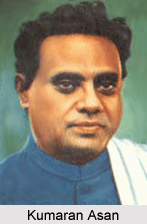 Kumaran Asan was a modern Malayali poet, one of the oldest and most important members of the Great Trio of Modern Malayalam poetry. Kumaran Asan belonged to the Ezhava communtiy, which was discriminated against by the upper castes that monopolized the literary and cultural life of Kerala throughout his¬tory. Influenced by the teachings of the philosopher and cultural activist Narayana Guru, Asan wanted to create a new cultural ethic for Malayalam language based on En¬glish liberal education. Narayana Guru and Kumaran Asan also preached an increased adherence to the Sanskrit tradition. It was this factor that helped them to outwit the supporters of caste supremacy on every level of culture and politics.
Kumaran Asan was a modern Malayali poet, one of the oldest and most important members of the Great Trio of Modern Malayalam poetry. Kumaran Asan belonged to the Ezhava communtiy, which was discriminated against by the upper castes that monopolized the literary and cultural life of Kerala throughout his¬tory. Influenced by the teachings of the philosopher and cultural activist Narayana Guru, Asan wanted to create a new cultural ethic for Malayalam language based on En¬glish liberal education. Narayana Guru and Kumaran Asan also preached an increased adherence to the Sanskrit tradition. It was this factor that helped them to outwit the supporters of caste supremacy on every level of culture and politics.
Kumaran Asan, unlike the other prominent poets of the time who wrote classical epics, published his long elegiacal poem Vina Poovu (A Fallen Bloom) in the year 1909. it was
a metaphor for the tragedy of human life in modern times. In many ways, much of the poetry of previous generations ignored human life, if it dealt with it at all. Those poets seemed to treat everything as an illusion and spoke in the idioms of the Hindu philosophers. Asan`s poetry moved away from the superficial philosophies and attempted to deal with more contemporary issues like bondage. He constantly wrote about the mechanical and de-humanizing life of individuals who have even been deprived of a fundamental sense of human dignity. His works were characterised by a never-seen-before clarity and romantic rage and cried out for the freedom of the individual. A low-caste individual`s assertion of identity and self-respect was an act of rebellion in the eyes of the higher castes, which, for centuries, refused to acknowledge such individuality. Asan`s poetry rendered, for the first time, the essence of the "low-caste" individual who possessed a higher moral authority than the oppressors. In effect, Asan`s poetry was confirming the essence of the collectivity that was historically denied.
Along with Asan`s nationalist aspirations, his poetry proclaimed free¬dom from the bondage of ignorance and political and personal silence. He de¬veloped an unfailing vision that included not only those who were oppressed but also the oppressors. Asan`s poetry aimed at bringing about a change in the human heart. In Duravastha, his most celebrated khandakavya (min¬iature epic), a Brahmin woman named Savitri marries Chathan, an untouchable, after he gave her refuge when her family home was destroyed in the Muslim revolt of Malabar (1921). This event takes place during a period when many Brahmins still considered lower-caste people untouchables. Having accepted the kindness of an untouchable, Savithri reciprocates his generosity by marrying him. This was provocative material in the eyes of the orthodox sections of society. Even distin¬guished critics like A. R. Rajaraja Varma, a part of the orthodoxy, sought to rebuke Asan`s great work for faulty Sanskrit style. But Kumaran Asan`s poetry found the right audience among the nationalists and the new, educated class.
Asan"s poetry was much strengthened by the fact that he was able to create conditions of human drama without giving in to adopting an instructive tone. Having transformed Malayalam poetry from the stale, usual cultural environment, Kumaran Asan was able to make his readers experience the horror of bondage, both external and internal. This was also the philosophical strategy of his mentor, Narayana Guru, whose followers became an immediate audience for Asan`s poetry.
In his miniature epics such as Nalini (1911), Leela (1914), Chandala Bhikshuki (The Beggar Woman, 1923), Chintavishtayaya Sita (Brooding Sita), and Karuna (Mercy, 1924), Kumaran Asan wrote eloquently about such issues as class oppression, feudalism, imperialism, materialism, untouchability, and un-approachability. Though there existed no gender-based cultural critique at this point, most of his works displayed a great understanding of womanhood. His heroines continue to inhabit the language as if they are actual human beings.
His work drew much strength from Buddhism, which challenged the inequalities of caste while offering realistic materials suitable to make his romantic art. For instance, Chandala Bhikshuki is about a low-caste woman named Matangi who offers, with misgiving, a drink of water to a young Buddhist monk, Ananda. His acceptance of it is in defiance of caste. She undergoes a conversion expe¬rience and becomes a Buddhist nun. In Karuna, the courtesan Vasavadatha is attracted to the Buddhist monk Upagupta, who keeps telling her that it is not yet time for him to enter her life. After the courtesan had murdered a merchant, she was apprehended, and her limbs were dismembered in punishment. For Asan, Vasavadatta is a metaphor of alienation and decay, and the poet seems to suggest that her longing for the monk`s presence is that of society`s desire for renewal. Upagupta the monk does arrive to comfort her with the compassion of Lord Buddha.
Thus the works of Asan occupy a rather important place in Malayalam literary works.













